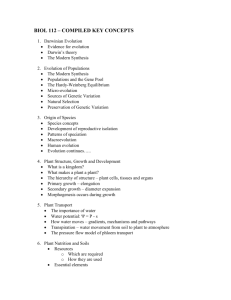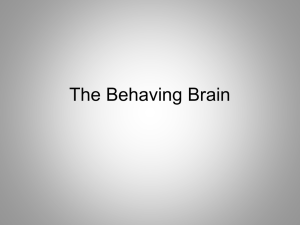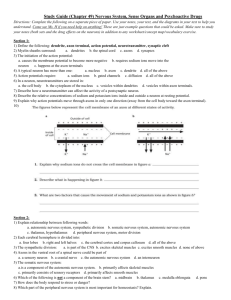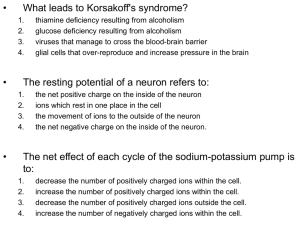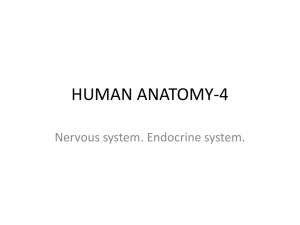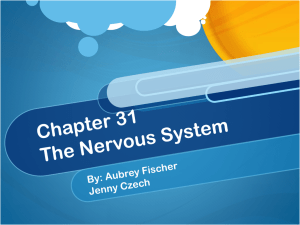BIOPSYCHOLOGY DOMAIN The Biological Bases of
advertisement
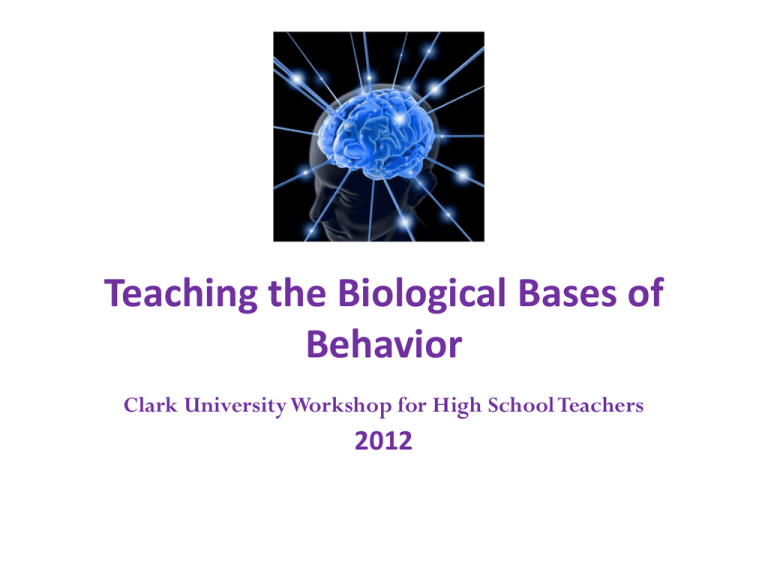
Teaching the Biological Bases of Behavior Clark University Workshop for High School Teachers 2012 BIOPSYCHOLOGY DOMAIN The Biological Bases of Behavior How do systems of our body interact and affect human behavior? How do chemicals in our brain and body affect our behavior? Can a damaged brain repair itself? How are our thoughts, emotions, and behaviors a product of how our brain functions? Domains and Standards Areas Scientific Inquiry Domain Perspectives in Psychological Science Research Methods, Measurement, and Statistics Biopsychology Domain Biological Bases of Behavior Sensation and Perception Consciousness Development and Learning Domain Life Span Development Learning Language Development Sociocultural Context Domain Social Interactions Sociocultural Diversity Domains and Standards Areas Cognition Domain Memory Thinking Intelligence Individual Variations Domain Motivation Emotion Personality Psychological Disorders Applications of Psychological Science Domain Treatment of Psychological Disorders Health Vocational Applications Biopsychological Domain Standards Area: Biological Bases of Behavior Content Standards After concluding this unit, students understand: 1. Structure and function of the nervous system in human and non-human animals 2. Structure and function of the endocrine system 3. The interaction between biological factors and experience 4. Methods and issues related to biological advances Content Standards With Performance Standards Content Standard 1: Structure and function of the nervous system in human and non-human animals Students are able to (performance standards): 1.1 Identify the major divisions and subdivisions of the human nervous system. 1.2 Identify the parts of the neuron and describe the basic process of neural transmission. 1.3 Differentiate between the structures and functions of the various parts of the central nervous system. 1.4 Describe lateralization of brain functions. 1.5 Discuss the mechanisms of, and the importance of, plasticity of the nervous system. Content Standard 2: Structure and function of the endocrine system Students are able to (performance standards): 2.1 Describe how the endocrine glands are linked to the nervous system. 2.2 Describe the effects of hormones on behavior and mental processes. 2.3 Describe hormone effects on the immune system. Content Standard 3: The interaction between biological factors and experience Students are able to (performance standards): 3.1 Describe concepts in genetic transmission. 3.2 Describe the interactive effects of heredity and environment. 3.3 Explain how evolved tendencies influence behavior. Content Standard 4: Methods and issues related to biological advances Students are able to (performance standards): 4.1 Identify tools used to study the nervous system. 4.2 Describe advances made in neuroscience. 4.3 Discuss issues related to scientific advances in neuroscience and genetics. TOPSS Unit Plan : The Biological Bases of Behavior Lesson 1 Techniques to learn about the brain and neural function Show a videotape clip that relates change of behavior, i.e. loss of function, to damage to specific area of the brain selected from: The Story of Phineas Gage (The Brain Series Teaching Module 2), Life Without Memory: The Case of Clive Wearing (The Mind Series Teaching Module 24) or excerpt from The Man Who Mistook His Wife for a Hat. Use slides, transparencies, pictures and microscope slides to illustrate techniques used to learn about brain and neural function (Content Outline Lesson 1). Show a videotape clip illustrating techniques selected from: Overview of Brain Organization (The Brain Module 1), Recording Integrated Brain Activity (The Mind Module 5), excerpt from The Behaving Brain (from Discovering Psychology) or magazine/journal article — such as from the September 1992 Scientific American. Select from Questions for Discussion/Critical Thinking Lesson 2 The neuron — unit of structure and function of the nervous system Show the first few minutes of "The Behaving Brain" from the Discovering Psychology series dealing with the structure and function of the neuron. Use transparencies or pictures of the neuron, synapse, a graph of the electrical changes in axonal polarization during impulse propagation and the reflex arc to illustrate the relationship of structure and function. Have students do Module A: Neural Messages of the PsychSim computer lab series or do Activity 2.1 Neurons and Impulse Conduction or do Activity 2.2 Conduction Of A Neuronal Impulse or do Activity 2.3 Using Dominoes To Help Explain The Action Potential . Do Activity 2.4 Demonstrating Simple Behavior: Patellar, Pupillary and Plantar Reflexes . Select from Questions for Discussion/Critical Thinking http://www.apa.org/ed/precollege/topss/lessons/index.aspx http://science.education.nih.gov/supplements/nih2/addiction/default.htm http://science.education.nih.gov/supplements/nih2/addiction/guide/guide_toc.htm http://science.education.nih.gov/supplements/nih2/addiction/activities/activities_toc.htm Brain Awareness Week: The global campaign to increase public awareness about the progress and benefits of brain research runs all year via Facebook or Twitter (#brainweek). In 2013, the week will be March 11–17 http://www.dana.org/brainweek/ BAW Resources Downloadable materials from the Dana Alliance A collection of downloadable (PDF) puzzles and coloring sheets for partner use. Other Web Sites with Puzzles to Download Neuroscience for Kids: Online and printable games, puzzles, coloring sheets, and more. National Institute of Environmental Health Sciences “Kids’ Pages” (US): Online and printable games, coloring books, and puzzles, as well as a series of online optical illusions and brain teasers. Visit BAW Logos Visit Other BAW Graphic Materials http://faculty.washington.edu/chudler/neurok.html How will your students show you what they have learned? Sample Performance Indicators CS 1, PS 1.2 Identify the parts of the neuron and describe the basic process of neural transmission. Students may indicate this by : CS 1, Performance Standards: 1.3 Differentiate between the structures and functions of the various parts of the central nervous system. Students may indicate this by : 1.4 Describe lateralization of brain functions. Students may indicate this by : 1.5 Discuss the mechanisms of, and the importance of, plasticity of the nervous system Students may indicate this by : We would love to have your ideas for performance indicators in this domain. Please remember to submit your ideas for the domains you were assigned as well as others if you can!!! Maybe tonight over a cup of java we can share some ideas!!!!

